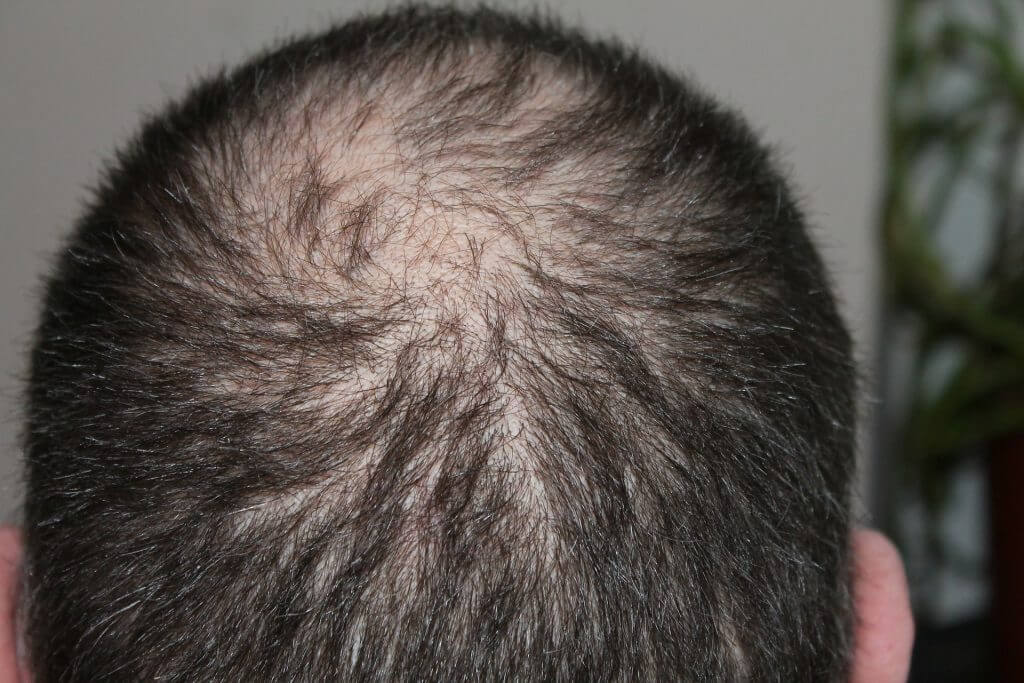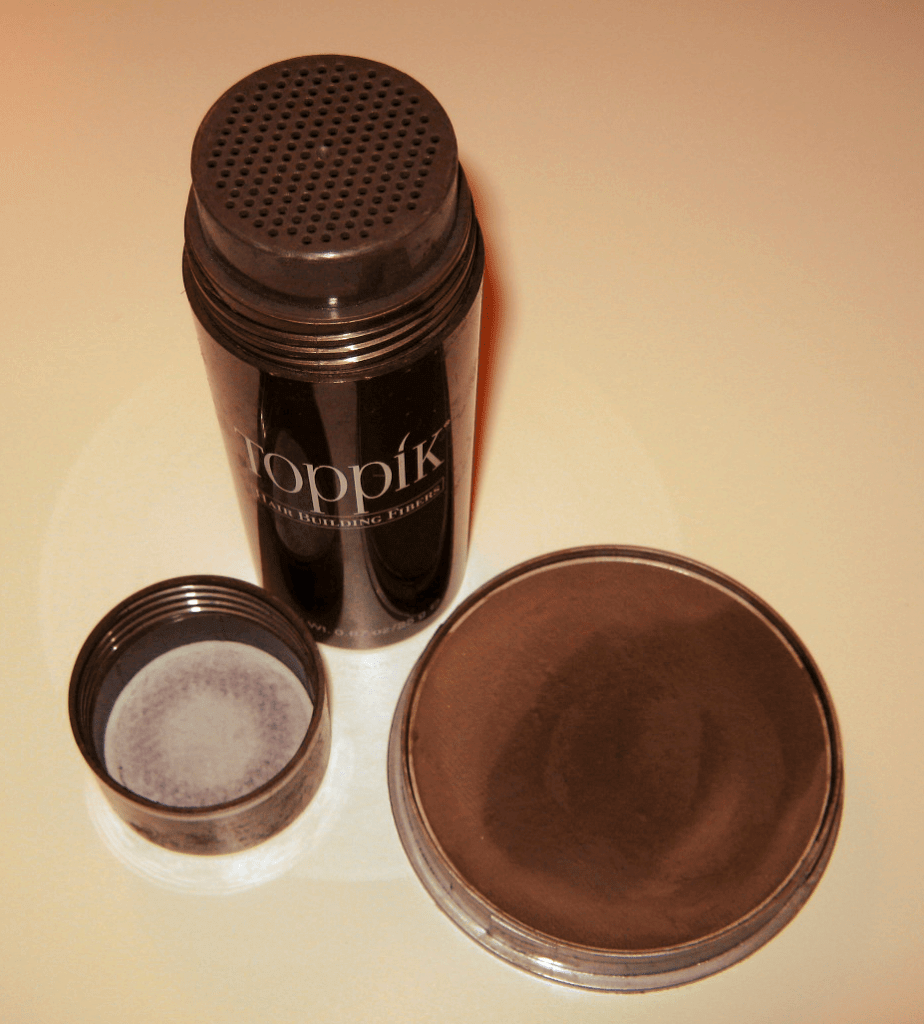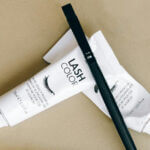
Applying hair building fibers exactly as recommended by manufacturers will not, in my experience, work well. And they don’t always work as a stand-alone product.
I used hair fibers for approximately three months. It was through trial and error that I devised the perfect application technique in order that they can work for any balding man who wishes to use them.
My Story
Having a nicely rounded dome, I’ve always enjoyed being bald. Back when I had a full head of hair, I’d keep cool every summer by shaving it off, in spite of my significant other of the time hating it.
Not being a hat man, I’d agree to grow it back in winter.
I don’t know exactly when it was, but at some point my barber told me my hair would be gone within five years.
I thought I’d detected a slight sparseness when running my fingers through it, or when looking in the mirror under strong lights. But now my barber had confirmed it; I’d soon be able to sport the bald, mustachioed look all year round.
I was delighted.
But as my thinning pate became more and more obvious, somebody else had other plans for me.
Being frugal, I would never have considered a hair transplant, regardless of my feelings toward hair loss. The bottle of minoxidil that appeared on my dresser was secretly applied to my chest; it didn’t make a lot of difference, by the way. But, to keep the peace, I did agree to sample the shaker of hair fibers.
What Are Hair Fibers?
Hair fibers are microfibers that appear as powders. They bond to the hair via a static charge, making it seem fuller and more abundant. Fiber powders are usually packaged in shaker containers for easy application.
There are two types of product: fibers made with natural keratin (the protein that is the primary component of human hair); and a synthetic variant.
Whichever I used, I found results to be the same. The only noticeable difference was price; a natural keratin product retails for a great deal more than any of its synthetic counterparts, like Hair So Real, also referred to as HSR.
Which Color to Choose
As I discovered the hard way, hair fibers must be of about the same degree of darkness as your hair. If they are too light, the effect will be powdery. If they are too dark, the color will seem patchy and too saturated to be natural.
For Gray and White Hair
Hair fibers are available in a number of colors, including gray and white. If you’re a combination of both, choose according to your dominant color.
What if Your Hair Is Highlighted?
If your hair is streaked or highlighted, use fibers of the same degree of darkness as your darkest hair.
Mixing Colors
If one shade is too dark and another too light, transfer the fibers to a plastic bag or Tupperware container with a lid, shake thoroughly, then pour back into their shakers. You should now have a perfect match for your hair.

How to Use Hair Fibers
A Step-By-Step Guide
After a few tries, this is how I found the fibers to best be applied:
- Wash and dry your hair. The fibers will not adhere well if the hair is not clean, and will become lumpy if it is damp or wet.
- In order to ensure that the fibers bind to the hair, shake the container before use to generate static electricity.
- Instead of just sprinkling, hold the container upside down over your head at a reasonable distance, and tap the bottom very lightly. This way, you’ll have more control over how much product you apply—too much will make your hair appear matted and unnatural. Or you could purchase a spray applicator, which fits onto the shaker. I didn’t try this, but let me know in the comments if you have.
- Direct the product firstly where your hair is at its thinnest, then add a lesser amount to the surrounding hair.
- Wipe away fibers that land on your forehead with a cotton pad. Or use a hairline optimizer. This will protect from fallout while creating a natural-looking hairline. Key to this, according to my experience, is to apply as little product as possible to the front.
- In spite of static electricity, the fibers still need fixing. Use hairspray or a spray-on gel, spraying from a distance to prevent blasting the fibers away. Direct the spray from where your hair is at its thinnest toward the thicker, surrounding hair to improve blending.
- If your style needs adjusting after spraying, do it before the spray sets using your fingers. Don’t use a comb or brush for this.
Why My Hair Fibers Didn’t Work the First Time
I experienced two problems at the beginning: my head looked powdery, and some fibers had slipped through my sparse hair and landed on my scalp, which was very noticeable under harsh lights, especially when I tilted my head back a little. A shorter person would have spotted it immediately.
If you pat your hair after step three above, as manufacturers recommend, it will only exacerbate the issue.
The Solution
The color was obviously too light, hence the powdery effect. I fixed this by mixing medium brown with dark brown—see “Mixing Colors” above. It gave a perfect match, and there was no waste.
And, as I discovered through further research, hair fibers work better in conjunction with hair loss concealer; especially if your hair loss is more advanced, as mine was.
Another bonus of using concealer is that fewer fibers are needed, which gives more natural-looking results.

Hair Loss Concealer
What Is Hair Loss Concealer?
There are two types of hair loss concealer. Both are rich in moisturizers, and both are safe for sufferers of alopecia, including androgenic alopecia (male pattern baldness).
- Products like DermMatch are colored, water-activated powders that mask bald patches, leaving a matte finish and an impression of depth and fullness, even under bright lights and strong sunshine.
- Products like Couvre do the same job, but are formulated as lotions. Although these tend to be available at a lower price than water-activated powder products, they don’t usually last as long.
When to Use Concealer
Start using hair loss concealer the moment you detect early thinning. Hair fibers can be used instead at this stage, but concealer works better and is less expensive in the long term.
The idea is that your progressing hair loss should go completely unnoticed by others.
Use fibers when your hair is too thin for hair loss concealer alone to be effective.
Which Color Should You Choose?
Because hair loss concealer is intended to create an impression of depth, make sure it’s either the exact same degree of darkness as your hair or a tad darker. A shade too light will appear powdery and unnatural.
Important is to think in terms of lightness and darkness rather than trying to get a perfect match.
How to Use Hair Loss Concealer
Apply hair loss concealer only where hair exists, whether it’s thinning hair or an area you’ve combed-over.
If you’re balding at the crown, comb your hair back. If your hairline and temples are thinning, get your barber to cut your hair so that it can be combed forward. With clever styling, you can also pull hair up from the sides to inconspicuously cover the temples.
You’ll obviously have to dampen the supplied sponge applicator before applying a water-activated product like DermMatch, but you’ll get a better finish if you do the same when using a lotion. Don’t literally wet the sponge; it should be only slightly damp.
Concealer is more easily applied to wet hair, but this can result in a dull, chalky appearance. If you find this to be the case, apply it to dry hair.
I always applied it to wet hair, before blow drying.
For a Thinning Hairline and Temples
To disguise thinning hair at the front and the temples, apply concealer from behind your hairline where you still have plenty of hair, blending toward the front with quick, short strokes in all directions. The concealer should completely fade out where your hairline begins. You can go a little over the hairline at the temples, but only if there’s enough hair to comb over.
If You’re Thinning at the Crown
If you’re thinning at the top and/or toward the back, blend from the center of the balding area in all directions toward and into the thicker surrounding hair. You’ll need an extra hand mirror to see what you’re doing.

Hair Fibers in Conjunction With Hair Loss Concealer
Above, I’ve given instructions for using hair fibers and hair loss concealer as stand-alone products.
Now a step-by-step guide to combining both products for more advanced thinning.
A Step-By-Step Guide
- Wash and towel dry your hair.
- If using, apply topical regrowth medications like minoxidil (e.g., Rogaine) and finasteride (e.g., Propecia).
- Apply pre-styling products like mousse.
- Comb your hair forward.
- Apply concealer.
- Dry your hair thoroughly.
- Comb or brush your hair into shape.
- Apply hair building fibers.
- Fix fibers with hairspray or spray-on gel.
If you prefer to apply concealer after drying in step six, go over your hair again with a dryer to get rid of any moisture retained in the concealer.
Do You Need Special Hair Care Products?
Expensive keratin shampoos and conditioners designed to complement concealers and fibers won’t noticeably “fatten” your hair, as manufacturers claim. Stick to regular hair care products formulated for your hair type.
Unless you tend to dryness, products formulated for fine hair may give more volume. But avoid so-called volumizing products. These coat the hair with silicone or other polymers, thus weighing it down.
Sprays marketed specifically to fix hair fibers don’t work any better than other hairsprays or spray-on gels.
What I Didn’t Like About Hair Fibers
As a temporary solution for thinning hair that’s both quick and affordable, there’s no doubt that hair fibers work for the purpose they are intended.
Applied properly, nobody suspected that my hair was full of cosmetics. It was accepted by all that my more abundant look was down to a new haircut.
But there were problems:
- If you don’t wash or cover your head before bed, your pillow will be a confounded mess by morning.
- You need enough time each day to “put your hair on.” And if it goes wrong, you’ll have to wash everything off and start over.
- You’ll have to guard your hair with your life if you don’t want people ruffling or running their fingers through it. And you can’t run your own fingers through it, for it will be too stiff with spray, and make a mess of your hands.
- Both concealer and fibers are sweatproof, but no matter what manufacturers claim, you won’t be able to get your hair too wet. That means you’ll have to carry an umbrella at all times, and a visit to the pool could prove awkward. But fibers do stand up to strong winds, as long as you’re wearing enough spray.
- You won’t be able to don any kind of headgear like caps, hats, hoods, and helmets, which may present a problem for motorcyclists and construction workers.
For How Long Will Concealer and Hair Fibers Work?
Male pattern baldness is ongoing, and concealers and fibers will only work for as long as you still have at least some hair. In other words, you probably won’t be able to use them forever.
Consider concealer and fibers a temporary measure while undergoing a hair regrowth treatment with minoxidil or finasteride, or while waiting until a hair transplant or hair replacement system becomes justifiable.
If you don’t intend to take a more permanent measure, perhaps it’s better to let nature take its course and embrace and accept inevitable baldness sooner rather than later, as I did.
I wore the fibers for the duration of one winter. As soon as the weather warmed, I liberated myself and shaved my remaining hair off, never to grow it again.
© 2024 J. Richardson
Related Posts
Disclaimer
The information provided by The Neat and Tidy Man (“we,” “us,” or “our”) on theneatandtidyman.com (the “site”) is for general informational purposes only. While we endeavor to keep the information up to date and correct, we make no representation or warranty of any kind, express or implied, regarding the completeness, accuracy, reliability, suitability, adequacy, validity, or availability of any information on the site. Under no circumstance shall we have any liability to you for any loss or damage of any kind incurred as a result of the use of the site or reliance on any information provided on the site. Your use of the site and your reliance on any information on the site is solely at your own risk.



